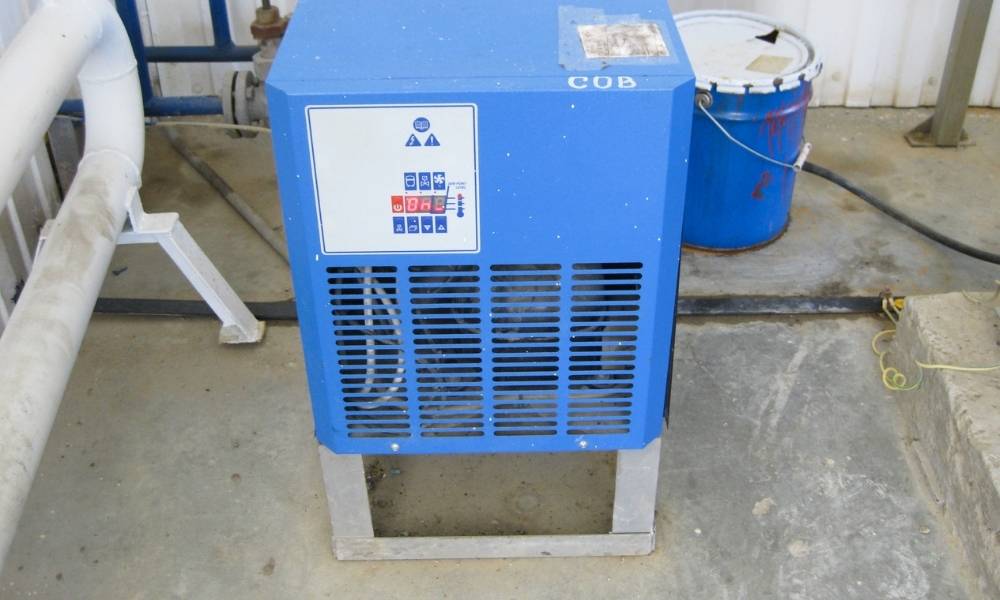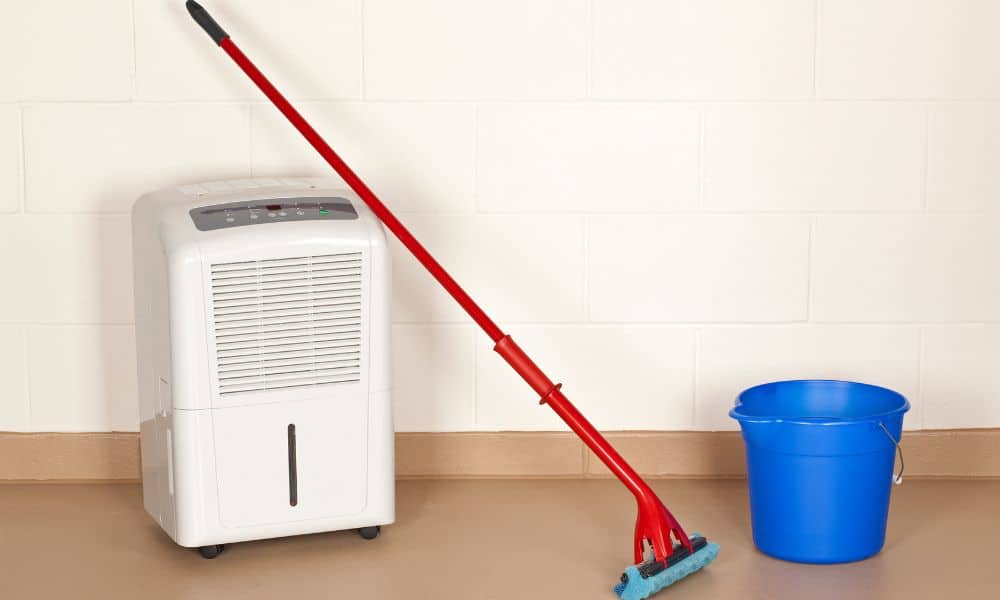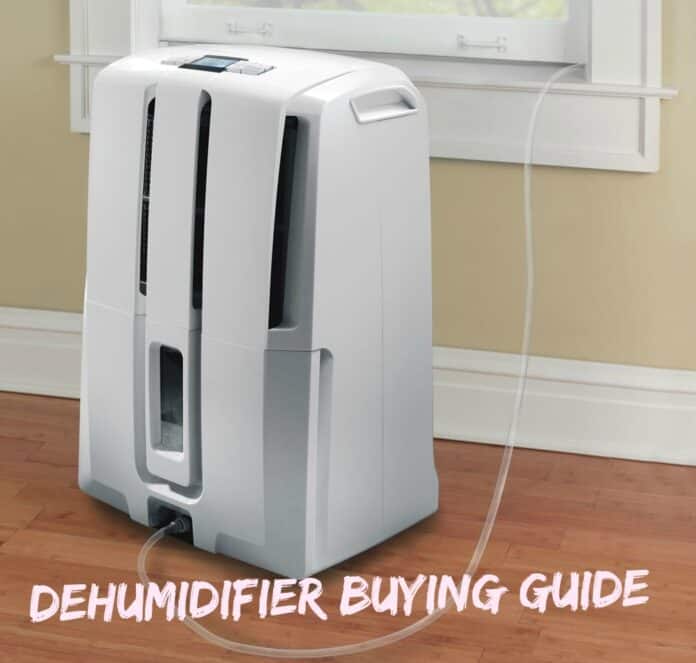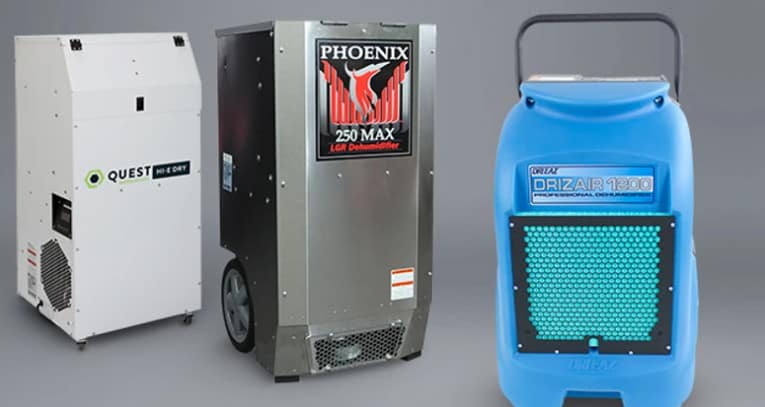If you have high humidity in your home, you should use a dehumidifier. These appliances remove moisture and help keep the desired humidity level. Maintaining a balanced humidity limits mold growth, reduces uncomfortable muggy conditions, and protects your home from damage.
Dehumidifiers are available in a variety of sizes and moisture removal capacities. Many models have a lot of good features that make your life easier. We have created this guide to help you understand how big and advanced a model you may need.
Table of Contents
Why Should You Use A Dehumidifier
The recommended indoor humidity level is between 30 and 50 percent. If a humidity level is higher than 60 percent, then it is considered high, and you should reduce it by 30 to 50 percent. And the best way to reduce a humidity level is by using a dehumidifier.
Lowering humidity is not the only reason why you should use a dehumidifier. There are other reasons too.
They are preventing Mold and Mildew Growth. The best way to stop a mold or mildew before it even happens is to maintain a healthier humidity level. Mold and mildew spores grow and reproduce in warm, wet conditions above 60 percent. The areas that are sensitive to mold infestations are basements, bathrooms, and kitchens. Use a dehumidifier regularly in these areas to help keep them dry and mold-free.
Managing Allergies. High moisture can increase common household allergy triggers like dust mites, mold spores, and airborne bacteria, which can grow and reproduce quickly in humid conditions. Keep humidity levels between 30 to 50 percent to make your space less hospitable to these allergy triggers and help you better manage your allergy symptoms.
Pest Control. Pests, for example, spiders, cockroaches, silverfish, and centipedes, love moist conditions. Keeping a drier space repels these pesky critters and keeps them out of your home for good.
Supplement Your Air Conditioner. Feeling chilly in your home lacks two things: excellent air and dry air. Apply a dehumidifier to increase your primary air conditioner to keep the air dry and save your AC from working overtime to reduce your humid space.
Home. Moisture damages your home, for example, support beams, buckling floorboards, hardwood floors, etc. Keep the humidity level below 60 percent to prevent costly repairs.
Ideal Place for a Dehumidifier

Dehumidifiers offer flexibility because of the variety of places in your home where you can place them.
- Basements – most of them are damp or wet. Place it there to save and protect your home’s structure.
- Bathrooms – everyone has seen how humid the bathroom is when you come out of the shower. If your bathroom has bad ventilation, it needs a dehumidifier. You don’t want mold in your bathroom.
- Garages – may be damp too.
- Spa and indoor pool areas usually have good ventilation but can also consider a dehumidifier.
- Water-damaged rooms
- Other places according to your own needs
How Do Dehumidifiers Work?
Through their operation, dehumidifiers remove water from the conditioned air.
Refrigeration.
This is the most common type. A fan sucks moisture in through a dehumidifier inlet. A humid air passes over cold tubes through which a coolant circulates. As the air cools, the moisture it contains turns into liquid water and drops off the tubes.
The free moisture air passes over a heating element, warms back up to its original temperature, and blows back into the room through the outlet. The atmosphere’s moisture initially drops into a bucket at the bottom of the machine.
It automatically turns off and switches on an indicator light when it is a whole dehumidifier, telling you the device needs emptying.
Which Type of Dehumidifier Do You Need?
Dehumidifiers are available in 2 main types: residential and commercial/industrial models.
Residential dehumidifiers

For separate spaces like basements or bathrooms, the best are residential dehumidifiers. They are portable and available in small, medium, and large moisture removal capacities. Usually, these dehumidifiers have many features such as electronic control panels, multiple fan speeds, casters, onboard humidistats, water buckets, and maybe Energy Star-qualified.
Whole House Dehumidifiers
For whole home needs, you can use a whole-home dehumidifier. They are connected to the HVAC system and dehumidify the air as it’s cooled. Dry, cool air is dispersed everywhere in your home through your ductwork.
You may also choose standalone whole-house dehumidifiers. They are portable and easy to set up and operate. It’s critical to place them in a centralized location in the practice space for the most efficient dehumidifying.
Commercial/industrial dehumidifiers
Commercial dehumidifiers are bigger and heavier-duty units made for more unforgiving dehumidifying jobs. These dehumidifiers have huge moisture removal capacities and can operate in extreme conditions.
These models have low-temperature operation internal condensate pumps, loss of power protection, and simplified controls. You might use an industrial dehumidifier to help remove moisture in a flood-damaged space or control humidity in an indoor pool area.
Some small industrial models are also more effective choices for residential basements and crawl spaces.
Choosing the Perfect Size Dehumidifier
Dehumidifier manufacturers show pints as capacity: the more pints, the better the performance.
For example, 40 points mean that the dehumidifier can remove 40 pints of moisture daily.
All dehumidifiers have stated how many pints of water they can remove.
You may question how to know if you need, for example, 30 pints per day or 70 pints? You can convert pints to square feet. But to do that, you must know at least how damp your space is. Is it only a little damp, moderately damp, or highly wet?
A little damp space has 50 to 60 percent humidity. It feels damp and has an occasional musty smell.
Moderately damp space often feels damp and often smells musty. The humidity level is between 60 and 70 percent.
The very damp place feels wet and musty; damp spots appear on the walls and floors. Humidity is between 70 to 85 percent.
Extremely wet space feels wet, smells musty; seepage appears on walls and floors; may have mold growth. Humidity is between 85 and 100 percent.
To help simplify your selection in size, take a look at the sizing chart below:
|
The condition |
Up to 500 |
501-1000 |
1001-1500 |
1501-2000 |
2001+ sq. |
|
A little damp 50-60% |
20 pints |
25 pints |
35 pints |
45 pints |
60+ pints |
|
Moderately damp 60-70% |
25 pints |
30 pints |
40 pints |
55 pints |
70+ pints |
|
Very damp 70-85% |
30 pints |
35 pints |
50 pints |
65 pints |
80+ pints |
|
Extremely wet 85-100% |
35 pints |
40 pints |
60pints |
75 pints |
90+ pints |
Capacity at AHAM vs. Capacity at Saturation
There are two ways of testing conditions for manufacturers to rate their dehumidifiers’ moisture removal capacities. The words AHAM and saturation refer to the circumstances in which dehumidifiers are tested.
AHAM grades are registered at average conditions of 60 percent humidity and 80 degrees Fahrenheit. These measurement circumstances are what the Association of Home Appliance Manufacturers suggests. AHAM conditions are supposed to give the most realistic representation of how a dehumidifier will work. The testing circumstances are so close to what most homes and structures will experience.
A saturation rating is recorded at 90 percent humidity and 90 degrees Fahrenheit, which serve much more intense conditions that won’t usually be experienced in the area.
Why should we test in situations that are rarely encountered?
Because measuring at saturation attends measure near the maximum volume of moisture, a presented unit can be obtained in a single day. It’s similar to describing a car’s top speed as a notice of overall achievement.
This makes a dehumidifier choice a bit complicated. Because when you search for a dehumidifier, you have to consider the testing conditions each model might have been rated in.
A dehumidifier that can remove 90 pints of water in saturation conditions (100% humidity) will only remove around 50 pints of water in AHAM conditions (60% humidity). That is because a dehumidifier extracts less water in the drier air than in more humid conditions.
Be sure to keep testing conditions in mind when you’re judging models. If you search for a dehumidifier for very wet space, look for a tested unit at AHAM. It will be more robust than a model rated at saturation.
Draining Dehumidifier
Dehumidifiers with refrigeration systems collect moisture and have to get rid of it somehow. Most dehumidifiers have buckets as the primary draining method, but there are other ways to get rid of it.
- As you may already know, most dehumidifiers come with a bucket or water reservoir. It’s effortless to empty a full bucket, but you have to do that very often, depending on how humid your space is. Most dehumidifiers come with smaller buckets than they can collect in a day. So if your area is very humid, avoid this method and keep reading below about other methods.
- Gravity Drain. This is the second most often used method to remove collected water. If the dehumidifier has a draining hose port, you can attach a hose to it and automatically let the dehumidifier water out. You can use various types of hoses. Keep in mind that most sellers don’t include them. The cons of this method are that you can’t move water upwards. And it would help if you put the other hose end somewhere.
- Internal Condensate Pump. The best method, in my opinion. This is what I call: set it and forget it. This method works only if a dehumidifier has this option. With this method, you can add a hose and pump water whenever you want – upwards outside the window, in your sink, or whenever you want. A dehumidifier will pump away the collected moisture automatically.
External Condensate Pumps
If a dehumidifier is equipped with a gravity drain, it can be used with an external condensate pump. This special accessory works as an internal condensate pump, pumping moisture out of the water reservoir. You must attach a hose from the gravity drain port on the dehumidifier to the pump. Then, you have to route another pipe from the pump to your chosen draining location.
Features to Look For
Almost all dehumidifiers have many features to add comfort to your life and help the unit best fit your needs. Most of the popular features you can see below:
Automatic Humidistat. Best feature out there. A humidistat automatically maintains your desired humidity level by triggering the dehumidifier to run only when needed. It helps to save energy.
Programmable Timer lets you program startup and shutoff times. Great if you don’t have time to turn it on or off.
Various Operating Modes and Speeds – Pick from multiple speeds and modes to find the best level of dehumidification for your needs.
Casters and Handles. Most dehumidifiers are quite large, which is why they have casters and handles. Also, almost all of the units which have water containers have them with handles.
Automatic Restart. The dehumidifier automatically restarts on power failure. Great feature.
Low-Temperature Operation. Most residential dehumidifiers operate successfully down to 41 degrees F. Look for this feature if you use your unit in a cooler crawl space or basement.
Automatic Defrost. In freezing temperatures, automatic defrost helps maintain your unit operational by defrosting any ice accumulation to reduce downtime.
Air Filter. Most household dehumidifiers have a washable air filter that catches allergens and particles and protects the unit’s internal components from debris damage.
Dehumidifier Noise Level
Most dehumidifiers, especially those with compressors and fans, work by moving air through them. And this process can be quiet only when moving a low amount of air.
As soon as these dehumidifiers start to move a decent amount of air, they become noisy.
How loud this noise will depend on the model. Some have a quiet operation (at least they present them as quiet). With these models, manufacturers have taken several steps to reduce noise by isolating the fan or using a smoother-running fan, for example.
The dehumidifier noise level is measured in decibels (dB). Most dehumidifiers are loud when working, but the good news is that 90% of the time, you don’t use them in spaces where you spend most of your time.
Fan Operation
A dehumidifier with a fan has two operation possibilities. One is when a dehumidifier fan runs continuously, and one is when the system is actively dehumidifying. Which is the best and more efficient? Read further.
Continuously fan run time. The fan is constantly on whether the compressor is running or not. With this operation, the fan helps move air always through the humidity sensor (if equipped) so that the dehumidifier measures the correct humidity level in the room.
This option helps a dehumidifier set the fan speed and consistently maintain your desired humidity level. Air is being dehumidified very effectively. Minus with a running fan is that it consumes more energy.
Fan Runtime Only When Dehumidifying. When the compressor turns off, also the fan turns off. It saves energy because the fan doesn’t run without a need and helps secure the system more efficiently.
So you still don’t understand which is more efficient? Because dehumidifiers with fans that run only when dehumidifying only save a small amount of energy, we would choose a dehumidifier with a continuous running fan. These models will more accurately sense your room’s humidity level and adjust operation accordingly, so you’ll get the best results and stay within your energy budget.
Dehumidifier Maintenance

Usually, dehumidifiers are trouble-free, but they do require maintenance. You will have to empty the water tank and clean the unit periodically to keep your home free of extra moisture, dust, and air pollutants such as mold and mildew that can harm your health. That will also help prolong your dehumidifier life and overall performance.
Here are some tips for better maintenance:
- Place your dehumidifier at least 6 inches (15.24 centimeters) apart from a wall so it does not block the air inlet or outlet.
- Close doors and windows. Keeping your doors and windows open will decrease your dehumidifier’s effectiveness in that area and may also raise your energy bill.
- Wait for at least 10 minutes to power your dehumidifier back on after turning it off. Some dehumidifiers have an automatic time delay before they start running again. Powering your dehumidifier off and on right away may cause your dehumidifier’s compressor to overheat.
- Clean the dehumidifier regularly. If it has a filter, clean it at least once per year. Clean the filter as the manufacturer has stated in the user manual.
- When emptying a water tank, scrub the inside with a brush using soap and water or use a disinfectant spray and paper towels.
- Oil your dehumidifier’s fan motor regularly using three drops of lubricating oil to keep your fan running smoothly and quietly.
- Dehumidifiers can last from 3 to 15 years. Performing the recommended maintenance and keeping your unit in excellent condition improves and lengthens the operating lifespan.




